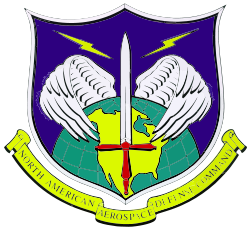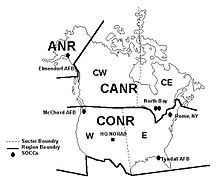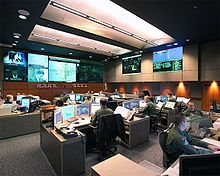- North American Aerospace Defense Command
-
North American Aerospace Defense Command Colorado Springs, Colorado, United States
NORAD emblemType Aerospace warning and aerospace control Coordinates 38°42′N 104°48′W / 38.7°N 104.8°WCoordinates: 38°42′N 104°48′W / 38.7°N 104.8°W Built 1961 (Directorate)[1] In use 1958 - present Current
ownerCanada / United States Controlled by Joint operations of
Royal Canadian Air Force and United States Air Force and co-location with USNORTHCOMGarrison Headquarters:Peterson Air Force Base
Directorate: Cheyenne Mountain Air Force Station[2]
(west of Colorado Springs, CO)Commanders General Charles H. Jacoby, Jr., USA Events May 2006 NORAD Agreement Renewal North American Aerospace Defense Command (NORAD,
 /ˈnɒræd/ norr-ad) is a joint organization of Canada and the United States that provides aerospace warning, air sovereignty, and defense for the two countries.[3] Headquarters NORAD is located at Peterson AFB, Colorado Springs, Colorado. NORAD command and control is exercised through the Cheyenne Mountain Operations Center, located a short distance away.
/ˈnɒræd/ norr-ad) is a joint organization of Canada and the United States that provides aerospace warning, air sovereignty, and defense for the two countries.[3] Headquarters NORAD is located at Peterson AFB, Colorado Springs, Colorado. NORAD command and control is exercised through the Cheyenne Mountain Operations Center, located a short distance away.Contents
Overview
The organization was established on May 12, 1958 (an effect of the Cold War) as a joint command between the governments of Canada and the United States, as the North American Air Defense Command. Its main technical facility has been the Cheyenne Mountain Directorate, formerly Cheyenne Mountain Operations Center, of the Cheyenne Mtn. Air Force Station, Colorado; and for this reason NORAD is sometimes referred to as Cheyenne Mountain.
Similar to the Cheyenne Mountain Directorate, but on a smaller scale, the Canada East and Canada West Sector Air Operations Control Centres were located in an underground complex 600 feet below the surface at Canadian Forces Base (CFB) North Bay in Ontario, Canada. On October 12, 2006, NORAD operations at CFB North Bay have officially moved above ground into the newly-constructed Sergeant David L. Pitcher Building, and the underground complex has been "mothballed" but can be returned to operation if it should be needed again.
Organization
The Commander of NORAD and U.S. Northern Command (USNORTHCOM) maintains a headquarters and command center at Peterson Air Force Base in Colorado Springs, Colorado. The NORAD and USNORTHCOM Command Center serves as a central collection and coordination facility for a worldwide system of sensors designed to provide the commander and the leadership of Canada and the U.S. with an accurate picture of any aerospace or maritime threat[4]. NORAD has administratively divided the North American landmass into three regions, the Alaska NORAD (ANR) Region, under Eleventh Air Force; the Canadian NORAD (CANR) Region, under 1 Canadian Air Division, and the Continental U.S. (CONR) Region, under 1 AF/CONR-AFNORTH. Both the CONR and CANR regions are divided into eastern and western sectors.
Alaska NORAD Region
The Alaska NORAD Region (ANR) maintains 24-hour-a-day, seven-day-a-week capability to detect, validate and warn of any atmospheric threat in its area of operations from its Regional Operations Control Center (ROCC) at Elmendorf AFB, Alaska.
ANR also maintains the readiness to conduct a continuum of aerospace control missions. These include daily air sovereignty in peacetime, contingency and/or deterrence in time of tension, and active air defense against manned and unmanned air-breathing atmospheric vehicles in times of crisis.
ANR is supported by both active duty and reserve units. Active duty forces are provided by Eleventh Air Force and the Canadian Forces, and reserve forces provided by the Alaska Air National Guard. Both 11 AF and the CF provide active duty personnel to the ROCC to maintain continuous surveillance of Alaskan airspace.
Canadian NORAD Region
1 Canadian Air Division/Canadian NORAD Region Headquarters is at CFB Winnipeg, Manitoba. It is responsible for providing surveillance and control of Canadian airspace. The Royal Canadian Air Force provides alert assets to NORAD. CANR is divided into two sectors, which are designated as the Canada East Sector and Canada West Sector. Both Sector Operations Control Centers (SOCCs) are co-located at CFB North Bay Ontario. The routine operation of the SOCCs includes reporting track data, sensor status and aircraft alert status to NORAD headquarters.
Canadian air defense forces assigned to NORAD include 441 and 416th Tactical Fighter Squadrons at CFB Cold Lake, Alberta and 425 and 433 Tactical Fighter Squadrons at CFB Bagotville, Quebec. All squadrons fly the CF-18 Hornet fighter aircraft.
In cooperation with the Royal Canadian Mounted Police and the United States drug law enforcement agencies, the Canadian NORAD Region monitors all air traffic approaching the coast of Canada. Any aircraft that has not filed a flight plan may be directed to land and be inspected by RCMP and Customs Canada.
Continental United States NORAD Region
- see also: Eastern Air Defense Sector (US East SOCC)
- see also: Western Air Defense Sector (US West SOCC)
The Continental NORAD Region (CONR) is the component of NORAD that provides airspace surveillance and control and directs air sovereignty activities for the Continental United States (CONUS).
CONR is the NORAD designation of the United States Air Force First Air Force/AFNORTH. Its headquarters is located at Tyndall AFB, Florida. 1 AF became responsible for the USAF air defense mission on 30 September 1990. AFNORTH is the United States Air Force component of United States Northern Command (NORTHCOM),
1 AF/CONR-AFNORTH comprises State Air National Guard Fighter Wings assigned an air defense mission to 1 AF/CONR-AFNORTH, made up primarily of citizen Airmen. The primary weapons systems are the F-15 Eagle and F-16 Fighting Falcon aircraft
It plans, conducts, controls, coordinates and ensures air sovereignty and provides for the unilateral defense of the United States. It is organized with a combined First Air Force command post at Tyndall AFB and two Sector Operations Control Centers (SOCC) at Rome, New York for the US East ROCC and McChord Field, Washington for the US West ROCC manned by active duty personnel to maintain continuous surveillance of CONUS airspace.
In its role as the CONUS NORAD Region, 1 AF/CONR-AFNORTH also performs counter-drug surveillance operations.
History
Formation
The growing perception of the threat of long-range Soviet strategic bombers armed with nuclear weapons brought the U.S. and Canada into closer cooperation for air defense. While attacks from the Pacific or Atlantic would have been detected by Airborne Early Warning aircraft, Navy ships, or offshore radar platforms, the Arctic was underprotected. In the early 1950s the U.S. and Canada agreed to construct a series of radar stations across North America to detect a Soviet attack over the Arctic. The first series of radars was the Pinetree Line, completed in 1954 and consisting of 33 stations across southern Canada. However, technical defects in the system led to more radar networks being built. In 1957, the McGill Fence was completed; it consisted of Doppler radar for the detection of low-flying craft. This system was roughly 300 miles (480 km) north of the Pinetree Line along the 55th parallel north. The third joint system was the Distant Early Warning Line (DEW Line), also completed in 1957. This was a network of 58 stations along the 69th parallel north. The systems gave around three hours' warning of a bomber attack before they could reach any major population center. Nonetheless, stopping incoming bombers was very difficult. During the three Operation Skyshield exercises of 1960 to 1962, only one quarter of friendly aircraft acting as Soviet bombers was intercepted.[5]
The command and control of the massive system then became a significant challenge. Discussions and studies of joint systems had been ongoing since the early 1950s and culminated on August 1, 1957, with the announcement by the U.S. and Canada to establish an integrated command, the North American Air Defense Command. On September 12, operations commenced in Colorado. A formal NORAD agreement between the two governments was signed on May 12, 1958.
On June 16, 1961, the official groundbreaking ceremony was held at the construction site of the NORAD Combat Operations Center (COC). Gen. Laurence S. Kuter, NORAD Commander, and Lt. Gen. Robert Merrill Lee, ADC Commander, simultaneously set off symbolic dynamite charges.
Cold War and false alarms
By the early 1960s, about 250,000 personnel were involved in the operation of NORAD. The emergence of the intercontinental ballistic missile (ICBM) and submarine-launched ballistic missile (SLBM) threat in the early 1960s was something of a blow. In response, a space surveillance and missile warning system was constructed to provide worldwide space detection, tracking and identification. The extension of NORAD's mission into space led to a name change, the North American Aerospace Defense Command in March 1981.
From 1963, the size of the U.S. Air Force was reduced, and obsolete sections of the radar system were shut down. However, there was increased effort to protect against an ICBM attack; two underground operations centers were set up, the main one inside Cheyenne Mountain and an alternate at North Bay, Ontario. By the early 1970s, the acceptance of mutual assured destruction doctrine led to a cut in the air defense budget and the repositioning of NORAD's mission to ensuring the integrity of airspace during peacetime. There followed significant reductions in the air defense system until the 1980s, when, following the 1979 Joint US-Canada Air Defense Study (JUSCADS) the need for the modernization of air defenses was accepted—the DEW Line was to be replaced with an improved Arctic radar line called the North Warning System (NWS); there was to be the deployment of Over-the-Horizon Backscatter (OTH-B) radar; the assignment of more advanced fighters to NORAD, and the greater use of Airborne Warning and Control System (AWACS) aircraft from Tinker Air Force Base in Oklahoma or Elmendorf Air Force Base in Alaska. These recommendations were accepted by the governments in 1985. The United States Space Command was formed in September 1985 as an adjunct but not a component of NORAD.
Even though all equipment in Cheyenne Mountain was put through a rigorous inspection, on at least three occasions, failure in its systems could have potentially caused nuclear war. On November 9, 1979, a technician in NORAD loaded a test tape but failed to switch the system status to "test", causing a stream of constant false warnings to spread to two "continuity of government" bunkers as well as command posts worldwide. On June 3, 1980, and again on June 6, 1980, a computer communications device failure caused warning messages to sporadically flash in U.S. Air Force command posts around the world that a nuclear attack was taking place.[6][7] During these incidents, Pacific Air Forces properly had their planes (loaded with nuclear bombs) in the air; Strategic Air Command did not and took criticism because they did not follow procedure, even though the SAC command knew these were almost certainly false alarms (as did PACAF).[citation needed] Both command posts had recently begun receiving and processing direct reports from the various radar, satellite, and other missile attack detection systems, and those direct reports simply did not match anything about the erroneous data received from NORAD.[citation needed]
Post–Cold War
At the end of the Cold War NORAD reassessed its mission. To avoid cutbacks, from 1989 NORAD operations expanded to cover counter-drug operations, especially the tracking of small aircraft entering and operating within America and Canada[8] (although commercial flights were not perceived to be threats). But the DEW line sites were still replaced, in a scaled-back fashion by the North Warning System radars between 1986 and 1995. The Cheyenne Mountain site was also upgraded. However, none of the proposed OTH-B radars are currently in operation.
Post–September 11, 2001
After the September 11, 2001 attacks, the NORAD mission evolved to include monitoring of all aircraft flying in the interior of the United States.[9] NORAD oversees Operation Noble Eagle using fighter aircraft Combat Air Patrols (CAP) under command of First Air Force and Airborne Warning and Control System (AWACS) E-3 Sentry aircraft under command of the 552nd Air Control Wing. At U.S. request, NATO deployed five of its NATO AWACS aircraft to the U.S. to help NORAD in the aftermath of the September 11 attacks.
On July 28, 2006, military officials announced that NORAD's day-to-day operations would be consolidated, for purposes of efficiency, in an ordinary building at Peterson Air Force Base in nearby Colorado Springs.[10] The mountain will be kept only as a backup in "warm standby," though fully operational and staffed with support personnel should the need arise. NORAD officials stated that the same surveillance work can be continued without the security the facility provides. They emphasized that they are no longer concerned about a halt to their operations from an intercontinental nuclear attack.
NORAD commander Admiral James A. Winnefeld, Jr. said in 2010 that NORAD did not send interceptors to intercept every flight of Russian bombers near U.S. airspace because NORAD did not wish to feed Russia's propaganda about their illusion of power.[11]
Commanders and deputy commanders
The Commander of NORAD is always a United States Defense Department Officer confirmed by the US Senate and from 2002 has simultaneously headed USNORTHCOM, while the Deputy Commander is always Canadian. During the course of NORAD's history there have been four different United States commands associated with NORAD:
Name of Command Abbreviations Emblem Association started Association ended Type of combatant command Notes Air Defense Command
Aerospace Defense CommandADC
ADCOM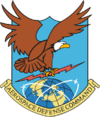
15 November 1957 31 March 1980 specified command Air Defense Command re-designated as Aerospace Defense Command, 15 January 1968. A new JCS Unified Command Plan designated ADC as a specified command and changed its name to the Aerospace Defense Command (ADCOM) on 1 July 1975. ADCOM inactivated on 31 March 1980 as specified command. Some components of ADCOM were reassigned to the Aerospace Defense Center, a USAF direct reporting unit assigned to Headquarters, NORAD that inactivated on 1 October 1986. Air Defense, Tactical Air Command ADTAC 
1 October 1979 1 July 1987 Air Division Resource management responsibility of ADCOM's atmospheric defense units transferred to Tactical Air Command; ADTAC established under TAC at Air Division echelon level for command of transferred ADCOM forces. United States Space Command USSPACECOM 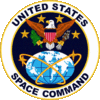
September 23, 1985 October 1, 2002 functional unified command merged with United States Strategic Command United States Northern Command USNORTHCOM 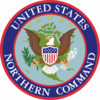
October 1, 2002 continuing regional unified command Commanders
The NORAD commander is an American four-star General, or equivalent. Since 2004 commanders have included Admirals.
NORAD Commanders Number Name Photo Start of term Association ended Notable positions held before or after 1 General Earle E. Partridge, USAF 
1957 1959 World War I enlisted Army combat veteran, participated in two major ground offensives on Western Front; USMA class 1924; USAAF CS Fifteenth Air Force DC Eighth Air Force World War II; Commander USAF Far East Air Forces, 1954. 2 General Laurence S. Kuter, USAF 
1959 1962 Commander 1st Bombardment Wing, Eighth Air Force; DC, Northwest African Tactical Air Force; Commander Atlantic Division, Air Transport Command; Commander, Military Air Transport Service; Commander, Far East Air Forces 3 General John K. Gerhart, USAF 
1962 1965 4 General Dean C. Strother, USAF 
1965 1966 U.S. Military Representative, NATO Military Committee, 1962–1965 5 General Raymond J. Reeves, USAF 
1966 1969 6 General Seth J. McKee, USAF 
1969 1973 7 General Lucius D. Clay, Jr., USAF 
1973 1975 8 General Daniel James, Jr., USAF 
1975 1977 9 General James E. Hill, USAF 
1977 1979 10 General James V. Hartinger, USAF 
1980 1984 11 General Robert T. Herres, USAF 1984 1987 1st Vice Chairman of the Joint Chiefs of Staff (1987–1990) 12 General John L. Piotrowski, USAF 
1987 1990 22nd Vice Chief of Staff of the Air Force (1985–1987) 13 General Donald J. Kutyna, USAF 
1990 1992 Member of the Rogers Commission (1986–1988) 14 General Charles A. "Chuck" Horner, USAF 
June, 1992 September, 1994 Commander, 9th Air Force, and Commander, U.S. Central Command Air Forces (1987–1992), he led U.S. and allied air operations for Operations Desert Shield and Desert Storm. 15 General Joseph W. Ashy, USAF 
September, 1994 August, 1996 16 General Howell M. Estes III, USAF 
August, 1996 August 14, 1998 17 General Richard B. Myers, USAF 
August 14, 1998 February 22, 2000 5th Vice Chairman of the Joint Chiefs of Staff (2000–2001)
15th Chairman of the Joint Chiefs of Staff (2001–2005)18 General Ralph E. "Ed" Eberhart, USAF 
February 22, 2000 November 5, 2004 27th Vice Chief of Staff of the Air Force (1997–1999) 19 Admiral Timothy J. Keating, USN 
November 5, 2004 March 23, 2007 Director of the Joint Staff (2003–2004)
Commander, U.S. Pacific Command (2007–2009)20 General Victor E. Renuart Jr., USAF 
March 23, 2007 May 19, 2010 Senior Military Assistant to the Secretary of Defense (2006–2007) 21 Admiral James A. Winnefeld, Jr., USN 
May 19, 2010 August 3, 2011 Director for Strategic Plans and Policy, The Joint Staff which he concurrently served as the Senior Member, U.S. Delegation to the U.N. Military Staff Committee (2008–2010) 22 General Charles H. Jacoby, Jr., USA 
August 3, 2011 Director for Strategic Plans and Policy, J5 Deputy commanders
In recent years deputy commanders have always been Canadian air force lieutenant generals. Prior to the 1968 unification of the Canadian Forces, the deputy commanders were RCAF Air Marshals.[12]
NORAD Deputy Commanders Number Name Photo Start of term Association ended Notable positions held before or after 1 Air Marshal Roy Slemon, CB, CBE, CD, RCAF 
September 1957 August 1964 Chief of the Air Staff (1953–1957) 2 Air Marshal Clarence Rupert Dunlap, CBE, CD, RCAF 
August 1964 August 1967 Deputy Chief of Staff (Operations) at Supreme Headquarters Allied Powers Europe (1958–1962), Chief of the Air Staff (1962–1964) 3 Air Marshal William R. MacBrien OBE, CD, RCAF 
August 1967 January 1969 4 Lieutenant-General Frederick Ralph Sharp CMM, DFC, CD 
January 1969 September 1969 Chief of the Defence Staff (1969–1972) 5 Lieutenant-General Edwin Reyno, CF September 1969 August 1972 Chief of Personnel of the Canadian Forces (1966–1969) 6 Lieutenant-General Reginald J. Lane, DSO, DFC and Bar, CD, LoM (USA) September 1972 October 1974 Deputy Commander of Mobile Command (1969–1972)[13] 7 Lieutenant-General Richard C . Stovel, AFC, CD, LoM (USA) October 1974 September 1976 8 Lieutenant-General David R. Adamson September 1976 August 1978 9 Lieutenant-General Kenneth E. Lewis 1978 1980 10 Lieutenant-General Kenneth J. Thorneycroft June 1980 May 1983 11 Lieutenant-General Donald C. MacKenzie, CF May 1983 August 1986 12 Lieutenant-General Donald M. McNaughton, CF August 1986 August 1989 13 Lieutenant-General Robert W. Morton, CMM, CD, BSc (RMC) August 1989 August 1992 [14] 14 Lieutenant-General Brian L. Smith August 1992 August 1994 [14] 15 Lieutenant-General J. D. O'Blenis, CF August 1994 August 1995 16 Lieutenant-General L. W. F. Cuppens, CF August 1995 April 1998 17 Lieutenant-General G C Macdonald, CF April 1998 August 2001 18 Lieutenant-General Ken R. Pennie, CF August 8, 2001 July 14, 2003 Chief of the Air Staff (2003–2005) 19 Lieutenant-General Rick Findley CF 
July 14, 2003 August 2, 2007 Chief of Staff for Personnel, Training, and Reserves; Chief of Staff for Operations at 1 Canadian Air Division; Director of Combat Operations at NORAD 20 Lieutenant-General Charles Bouchard CMM CD CF 
August 2, 2007 July 10, 2009 Deputy Commander for Continental NORAD Region, Deputy Commander of Allied Joint Force Command Naples 21 Lieutenant-General Marcel Duval CMM CF 
July 10, 2009 August 15, 2011 Canadian Contingent Commander Middle East; Commander of 1 Wing 21 Lieutenant-General Thomas J. Lawson CMM CD CF 
August 15, 2011 Assistant Chief of the Air Staff Legacy organizations
- 20th NORAD Region, 1966–1967; 1969–1983
- 21st NORAD Region, 1966–1967; 1969–1983
- 22d NORAD Region, 1966–1987
- 23d NORAD Region, 1969–1987
- 24th NORAD Region, 1969–1990
- 25th NORAD Region, 1966–1990
- 26th NORAD Region, 1966–1990
- 27th NORAD Region, 1966–1969
- 28th NORAD Region, 1966–1969; 1985–1992
- 29th NORAD Region, 1966–1969
- 30th NORAD Region, 1966–1968
- 31st NORAD Region, 1966–1969
- 32d NORAD Region, 1966–1969
- 34th NORAD Region, 1966–1969
- 35th NORAD Region, 1966–1969
- 36th NORAD Region, 1966–1969
- Northwest Air Defense Sector, 1987–1995
- Northeast Air Defense Sector, 1987–2009
- Southeast Air Defense Sector, 1987–2005
- Southwest Air Defense Sector, 1987–1995
Notable popular culture
NORAD comes to the public's attention during December and on Christmas Eve, when its NORAD Tracks Santa service follows Santa Claus on his journey around the world. This tradition started in 1955 when a local Sears store in Colorado misprinted the telephone number and children thought they were calling Santa, but actually were calling Air Defense Command (NORAD's predecessor) instead.[15]
Cheyenne Mountain was the central setting of the 1983 motion picture WarGames, starring Matthew Broderick as a teenager who hacked NORAD's main computer and almost started a global thermonuclear war.
Cheyenne Mountain is also the main Earth setting of the Stargate universe, serving as the Command Center for all Stargate Operations in the Milky Way Galaxy.
See also
- United States Space Surveillance Network
- CFB North Bay
- Air Force National Security Emergency Preparedness Agency
- Air Forces Northern National Security Emergency Preparedness Directorate
- NORAD Tracks Santa Program
- Defence Diplomacy
- Hawaii Region Air Operations Center
- North Warning System
- Joint Surveillance System
Notes
- ^ NORAD Official History
- ^ Cheyenne Mountain Directorate Official Page
- ^ NORAD Official Site
- ^ http://www.norad.mil/about/index.html
- ^ Mola, Roger (2002-03-01). ""This Is Only a Test"". Air & Space. http://www.printthis.clickability.com/pt/cpt?expire=&title=%22This+Is+Only+a+Test%22+%7C+History+of+Flight+%7C+Air+%26+Space+Magazine&urlID=28735199&action=cpt&partnerID=285287&cid=16044207&fb=Y&url=http%3A%2F%2Fwww.airspacemag.com%2Fhistory-of-flight%2Fthis-is-only-a-test.html. Retrieved October 12, 2011.
- ^ "NORAD's Missile Warning System: What Went Wrong? (MASAD-81-30)". U.S. Government Accountability Office. U.S. GAO. May 15, 1981. http://archive.gao.gov/f0102/115265.pdf. Retrieved November 3, 2010.
- ^ "Attack Warning: Better Management Required to Resolve NORAD Integration Deficiencies (IMTEC-89-26)". U.S. Government Accountability Office. U.S. GAO. July 7, 1989. http://archive.gao.gov/d25t7/139055.pdf. Retrieved November 3, 2010.
- ^ FAS: Cheyenne Mtn Complex
- ^ "Cheyenne Mountain Division - Air Warning Center (AWC) by NORAD Public Affairs". NORAD. http://www.norad.mil/about/CMOC_2.html#AWC. Retrieved 2009-12-31.
- ^ "After 4 Decades, a Cold War Symbol Stands Down, July 29. 2006, by Kirk Johnson". New York Times. July 29, 2006. http://www.nytimes.com/2006/07/29/washington/29norad.html?_r=2&oref=slogin. Retrieved 2009-12-31.
- ^ Russia's Air Defense 'Responds' To All Aircraft Near Its Airspace, July 16, 2010
- ^ Veale, Thomas F. (2008). Guarding What You Value Most: North American Aerospace Defense Command, Celebrating 50 Years. Government Printing Office. p. 49. ISBN 9780160804366.
- ^ http://www.aircrew.ca/RCAF%20Memorial%20Cairn.pdf
- ^ a b Royal Military Colleges Class of
- ^ "North American Aerospace Defense Command - NORAD Tracks Santa". NORAD. http://www.norad.mil/about/Santa.html. Retrieved 2009-12-31.
References
Bibliography
- Cole, Ronald H.; Poole, Walter S.; Schnabel, James S.; Watson, Robert J.; Webb, Willard J. The History of the Unified Command Plan 1946-1993. Washington DC, Joint History Office, Office of the Chairman of the Joint Chiefs of Staff, 1995.
- Trask, Roger R.; Goldberg, Alfred; The Department of Defense, 1947-1997: organization and leaders. Washington DC, Historical Office, Office of the Secretary of Defense, 1997.
External links
- NORAD Home Page
- Official NORAD Santa Tracker (multi-lingual) and official seasonal hotline: 1-877-Hi-NORAD
- CBC Digital Archives - Norad: Watching the Skies
- Colonel Stephen P. Moeller, Vigilant and Invincible, ADA Magazine, May–June 1995 - covers the U.S. Army Air Defense Command (ARADCOM) 1950s-1974
- 'Rings of Supersonic Steel: Air Defenses of the United States Army 1950-1979'
 Air Force Space Command (AFSPC)
Air Force Space Command (AFSPC)Air Forces 
Centers Space and Missile Systems Center · Space Innovation & Development Center · 614th Air and Space Operations Center · 624th Operations Center · Air Force Network Integration CenterBases Stations Cape Canaveral · Cape Cod · Cavalier · Cheyenne Mountain · Clear · Kaena Point · New Boston · Onizuka (closed)Wings SpaceAcquisitionAir BaseCyberGroups Combat CommCyberSquadrons Space AggressorCommand and ControlSpace CommunicationsSpace ControlSpace Development1st • 2d • 3dSpace ExperimentationSpace LaunchSpace OperationsSpace SurveillanceSpace TestSpace Weather55thSpace WarningLists relating to aviation General Aircraft (manufacturers) · Aircraft engines (manufacturers) · Airlines (defunct) · Airports · Civil authorities · Museums · Registration prefixes · Rotorcraft (manufacturers) · TimelineMilitary Accidents/incidents Records Categories:- North American Aerospace Defense Command
- Military units and formations in Colorado
- Military facilities in Colorado
- Aerospace
- Organizations based in Colorado Springs, Colorado
- Organizations established in 1958
- Canada–United States relations
- Military alliances involving Canada
Wikimedia Foundation. 2010.

